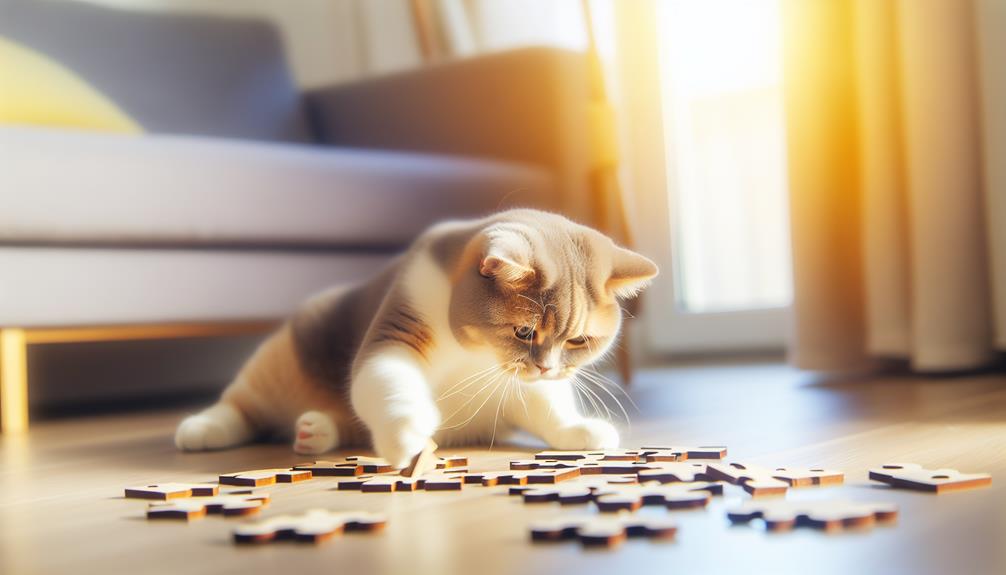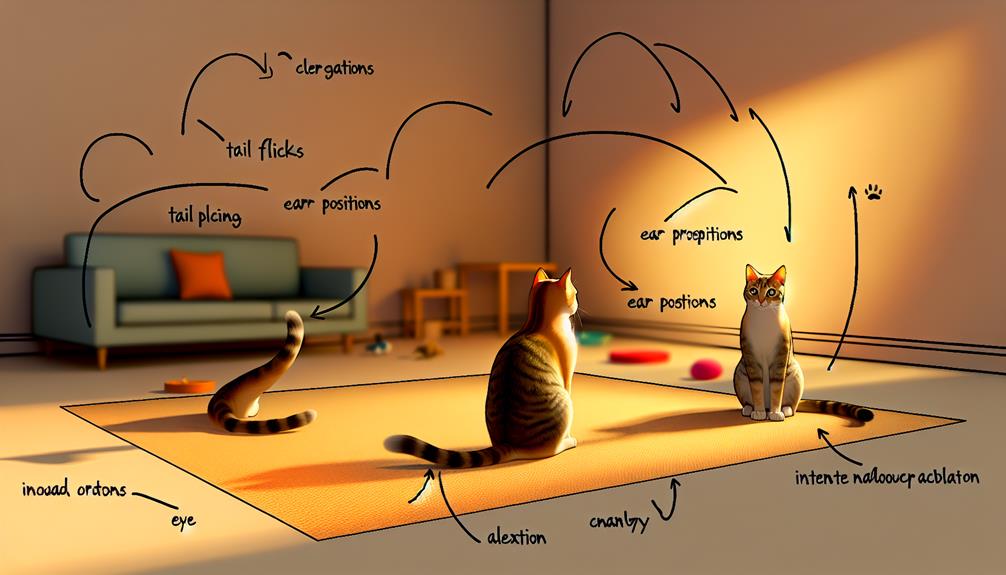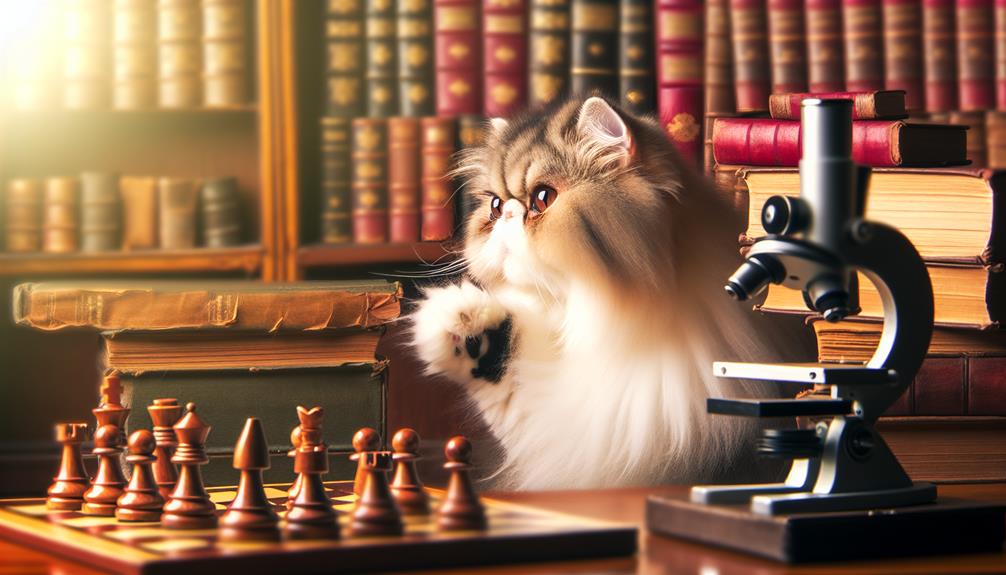Imagine a feline maneuvering the maze of life, each turn a tribute to its intelligence. You might think cats are simply driven by instinct, but their cognitive abilities suggest something much deeper. Have you noticed how they solve problems, remember intricate details, and adapt to new environments? Their social awareness and communication methods are more nuanced than they seem. If you've ever wondered just how smart your cat really is, you'll find that their intelligence goes far beyond the surface, revealing a complex and fascinating aspect of their nature.
Cognitive Abilities
When examining the cognitive abilities of cats, it's clear these creatures possess a remarkable level of intelligence. Feline intelligence manifests in various forms, from their instinctual behavior to their sophisticated sensory perception. Cats demonstrate impressive environmental adaptability, seamlessly adjusting to new surroundings and situations.
Cat cognition is often linked to their hunting strategies. Even domestic cats exhibit predatory skills through play behavior, mimicking the hunt by stalking and pouncing on toys. This play behavior isn't just frivolous; it's a vital aspect of their cognitive development and physical conditioning.
Social hierarchy within multi-cat households further underscores feline intelligence. Cats maneuver complex social structures, showing an understanding of dominance and submission. This social awareness is a reflection of their cognitive capabilities and adaptability.
Attention span in cats can be quite focused, particularly when engaged in activities that pique their interest, such as hunting or playing. However, this attention can be fleeting in less stimulating situations, indicating a selective attention span that aligns with their survival instincts.
Learning styles in cats vary, influenced by individual temperament and experiences. Some cats learn through observation, while others require direct interaction. Their ability to learn from their environment and experiences showcases their cognitive flexibility.
Sensory perception in cats is highly refined, aiding their cognitive processes. Their acute senses of sight, hearing, and smell are essential for traversing their environment and executing hunting strategies. This heightened sensory perception supports their instinctual behavior and enhances their overall intelligence.
Memory and Learning
When you examine a cat's memory and learning, you'll notice their impressive short-term memory capacity, often allowing them to recall recent events with surprising accuracy. Their problem-solving abilities further highlight their intelligence, as they can navigate complex environments and adapt their strategies to achieve goals. Observing these traits provides valuable insights into their cognitive processes and adaptability.
Short-term Memory Capacity
A fascinating aspect of feline intelligence lies in their short-term memory capacity, which considerably influences their ability to learn and adapt. Cats exhibit notable memory retention, allowing them to recall various stimuli, such as the location of food or the presence of a threat, for a short period. This feline recall ability is essential for their survival, enabling them to navigate complex environments with precision.
Studies have shown that cats can remember specific events or objects for up to 16 hours, a duration that surpasses many other animals, including dogs. This enhanced short-term memory capacity aids in their learning processes, making them adept at tasks that require quick thinking and adaptability. For instance, a cat can swiftly learn the layout of a new home or remember the hiding spot of a favored toy.
In observing feline behavior, you'll notice that their memory retention plays a significant role in their daily activities. They can remember where they last saw a particular object or person, which highlights their cognitive abilities. This capacity for short-term memory not only underscores their intelligence but also provides insight into their sophisticated learning mechanisms.
Problem-Solving Abilities
Building on their impressive short-term memory, cats exhibit remarkable problem-solving abilities that further highlight their cognitive prowess. When faced with challenges, cats rely on a combination of cat cognition and instinctual learning to navigate their environment. For instance, they've been observed manipulating objects, such as opening doors or drawers, demonstrating a high level of feline intelligence and behavioral adaptability.
You might notice that cats can learn from past experiences, which reinforces their ability to solve problems. This adaptability is evident when a cat encounters a new puzzle, such as a treat-dispensing toy. They'll first experiment with various methods, and through trial and error, they'll determine the most effective strategy. This capacity to learn and remember solutions showcases their sophisticated cognitive functions.
Moreover, cats possess an exceptional ability to recognize patterns and anticipate outcomes. For example, they can quickly learn that a specific sound, like a can opener, predicts mealtime. This pattern recognition isn't just limited to food-related activities but extends to social interactions and environmental changes. Overall, the problem-solving abilities of cats underscore their impressive cognitive and adaptive nature, shedding light on the depth of feline intelligence.
Problem-Solving Skills

When considering a cat's problem-solving skills, you'll find their puzzle-solving abilities particularly fascinating. Cats demonstrate impressive memory and learning capabilities, often recalling solutions to tasks long after initial exposure. Additionally, there is evidence suggesting that some cats can use tools to achieve specific goals, further highlighting their cognitive prowess.
Puzzle Solving Abilities
Concerning puzzle-solving abilities, cats exhibit remarkable problem-solving skills that often go unnoticed. When provided with interactive toys, cats engage in play behavior that not only entertains them but also serves as behavioral enrichment. These toys offer environmental enrichment, stimulating their natural curiosity and driving exploration. Feline intelligence is evident when cats manipulate objects, demonstrating an understanding of cause and effect.
Cats' puzzle engagement is a clear indicator of their mental stimulation needs. Through curiosity driven exploration, they learn to navigate complex tasks, such as extracting treats from a puzzle feeder. These activities showcase their cognitive abilities and adaptability. Observational studies suggest that cats can remember and apply strategies to solve puzzles, indicating a high level of problem-solving prowess.
In a controlled environment, providing puzzles as part of behavioral enrichment can greatly enhance a cat's quality of life. The engagement in these activities not only prevents boredom but also promotes overall well-being. By analyzing the ways cats interact with puzzles, you can gain insights into their cognitive processes and appreciate their sophisticated problem-solving skills. Fundamentally, puzzle-solving abilities offer a window into the advanced mental faculties of felines.
Memory and Learning
In examining the memory and learning capabilities of cats, one can observe that their problem-solving skills are closely linked to their ability to retain and apply information. Feline intelligence is evident through their memory retention and learning behaviors. Cats exhibit a strong capacity for associative learning, where they link specific actions to outcomes, such as associating the sound of a can opener with food.
Long term memory plays a fundamental role in a cat's ability to navigate its environment and adapt to changes. You'll notice that cats remember the location of their favorite hiding spots or the path to their food bowls even after extended periods. This memory retention is supported by their acute sensory perception, allowing them to process and recall complex information.
Environmental adaptation is another aspect where their problem-solving skills shine. Cats can learn to open doors, navigate obstacles, and even manipulate their surroundings to suit their needs. Their instinctual learning, combined with observational learning from humans and other animals, enhances their ability to solve problems efficiently. Essentially, a cat's intelligence, bolstered by its memory and learning capabilities, equips it to tackle various challenges with remarkable adeptness.
Tool Use Evidence
Building upon the insights into feline memory and learning, it's intriguing to examine how cats exhibit problem-solving skills through tool use. While you might not see your cat wielding a hammer, their environmental interactions provide fascinating evidence of their cognitive abilities. For instance, their instinctual behavior and hunting strategies often involve using objects to achieve goals, showcasing adaptability skills.
Cats exhibit problem-solving in several ways:
- Object Manipulation: You've probably seen your cat use its paws to fish out toys from tight spaces. This behavior highlights their ability to manipulate objects to access resources.
- Play Behavior: Play isn't just fun; it's a crucial part of a cat's learning process. When your cat plays with puzzle toys, it demonstrates exploratory behavior and creative solutions to get treats.
- Resourcefulness Techniques: Cats have been observed using tools to drink water. They might dip their paw into a water bowl and then lick it, a clear sign of innovative problem-solving.
These behaviors show that cats aren't just passive animals but active problem-solvers. Their capacity for tool use, though not as advanced as primates, reveals a sophisticated level of intelligence that's often underestimated.
Social Intelligence
Contrary to popular belief, cats possess remarkable social intelligence that often goes unnoticed. Unlike the aloof stereotype, they form complex social hierarchies and establish feline friendships. Observing their play behavior reveals a sophisticated understanding of social dynamics, often dictated by territorial awareness and grooming rituals.
| Behavior | Observations |
|---|---|
| Social Hierarchies | Cats form rankings through subtle dominance and submission interactions. |
| Feline Friendships | Long-term bonds develop, characterized by frequent grooming and resting together. |
| Play Behavior | Play serves as a vehicle for learning social cues and establishing social bonds. |
Vocal communication in cats isn't just about demanding food; it's a nuanced system to convey needs and establish social bonding. They use different sounds and frequencies to interact not only with humans but also with fellow cats and other animals, exemplifying interspecies interactions. In addition, empathy signals, such as purring or rubbing against you when you're distressed, highlight their ability to pick up on human emotions.
Territorial awareness is another facet of their social intelligence. Cats navigate their environment with a keen sense of who belongs where, recognizing and respecting the territories of others. This behavior is intricately linked to their grooming rituals, which serve as a means of maintaining social bonds and reducing stress within their social groups.
Communication Methods

Although often underestimated, the communication methods of cats exhibit a high degree of complexity and sophistication. Their interactions rely on a blend of vocal communication, body language, and scent marking, enabling them to convey a wide array of messages.
Cats use vocal communication in various ways. Meowing variations can indicate different needs or states; a high-pitched meow may signal hunger, while a lower pitch could mean discomfort. Purring signals, often associated with contentment, can also indicate stress or pain. Understanding these nuances helps you interpret what your feline friend is trying to communicate.
Body language is another critical aspect. Tail positioning provides significant clues: a straight-up tail typically signifies friendliness, while a puffed-up tail indicates fear or aggression. Ear movements also play a role; forward-facing ears show interest, while flattened ears suggest aggression or fear. Eye contact, or lack thereof, can reveal trust or apprehension. Observing these subtle cues can enhance your interaction with cats.
Cats also employ physical behaviors to communicate:
- Grooming behaviors: Cats often groom themselves or others as a form of social bonding, known as social grooming. It fosters trust and strengthens social hierarchies.
- Scent marking: By rubbing their faces or bodies against objects, cats leave scent markers that convey ownership and territorial boundaries.
- Purring signals: While often signaling relaxation, purring can also serve as a self-soothing mechanism during stressful situations.
Emotional Awareness
Cats exhibit a remarkable degree of emotional awareness, allowing them to respond appropriately to both their environment and human emotions. This emotional intelligence is evident in their ability to recognize and react to mood changes in their human companions, demonstrating a form of feline empathy. When you're feeling sad or stressed, your cat might come closer, purr, or gently nuzzle you, engaging in interspecies communication that strengthens emotional bonding.
| Emotional Cue | Cat's Response |
|---|---|
| Human sadness | Increased nuzzling |
| Human anxiety signals | Purring and closeness |
| Calm environment | Relaxed behavior |
Cats also exhibit attachment behaviors similar to those seen in other domesticated animals. These behaviors are not just random acts but are rooted in their ability to form strong emotional bonds with their human caregivers. For instance, cats may follow you from room to room, seeking to maintain proximity, which is a clear indicator of their attachment.
Furthermore, cats are adept at mood recognition, a skill that allows them to navigate complex social interactions within a household. They can distinguish between a calm and a tense atmosphere, adjusting their behavior accordingly. For example, a cat might become more aloof if it senses heightened stress responses in its environment.
Behavioral cues such as tail flicking or ear flattening are also ways cats communicate their own anxiety signals. These subtle signs are vital for understanding their emotional state and ensuring their well-being. By observing these cues, you can better comprehend your cat's needs and enhance the emotional bonding you share.
Thus, through their nuanced emotional intelligence, cats engage in sophisticated interspecies communication that enriches the human-feline relationship.
Training and Tricks

Training and teaching tricks to cats might seem like a challenging endeavor, but it is entirely feasible with the right approach and understanding of feline behavior. Cats, while independent, can be motivated through various methods such as clicker training and treat rewards. By leveraging their natural curiosity and play motivation, you can effectively teach them a range of tricks and behaviors.
To start, consider the following steps:
- Clicker Training: This method uses a small device that makes a clicking sound to mark desired behaviors. When paired with treat rewards, it helps your cat associate the click with positive actions.
- Agility Training: Setting up an obstacle course with interactive toys and tunnels can engage your cat's natural agility. This not only provides physical exercise but also mental stimulation.
- Scent Games: Utilize your cat's keen sense of smell by hiding treats around your home. This encourages exploratory behavior and can be a fun way to practice obedience challenges.
Understanding behavioral cues is essential for training consistency. Cats respond well to positive reinforcement, so it's important to reward desired behaviors immediately. This creates a clear connection in your cat's mind between the action and the reward. Training sessions should be kept short to maintain your cat's interest and avoid overstimulation.
Interactive toys can also play a significant role in maintaining your cat's engagement during training. These toys can be used to reinforce learned behaviors and keep training sessions dynamic.
Ultimately, successful training hinges on patience and consistency. By observing your cat's reactions and adjusting your methods accordingly, you can overcome obedience challenges and foster a rewarding training experience.
Conclusion
In fundamental terms, your feline companions aren't just furry friends; they're sophisticated beings with a knack for maneuvering complexities. Their cognitive abilities, memory prowess, and problem-solving skills are commendable, while their social intelligence and communication nuances reveal a deeper emotional landscape. Through observation and interaction, cats exhibit a level of intelligence that's both surprising and enlightening. So, next time you watch your cat, remember you're not just seeing a pet, but an intricate mind at work.
